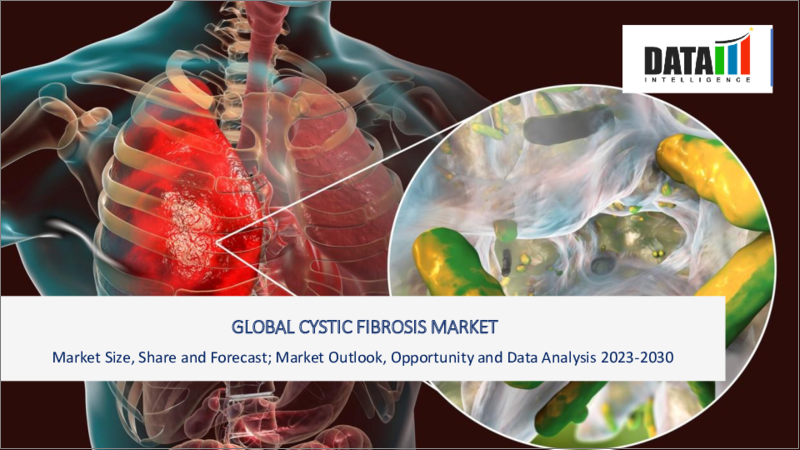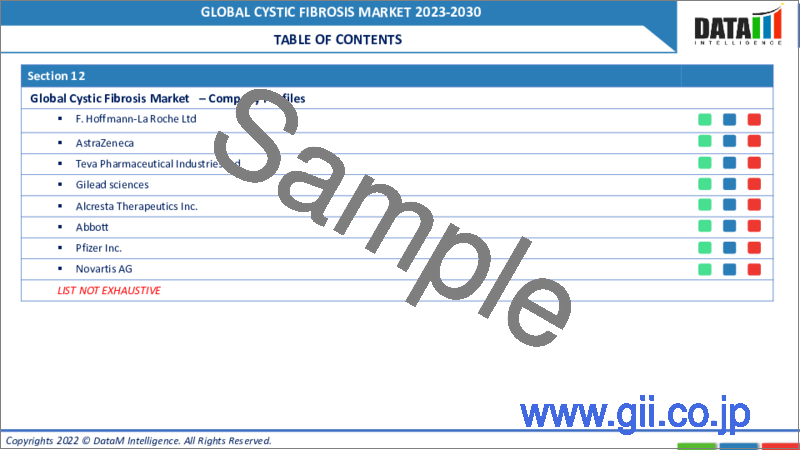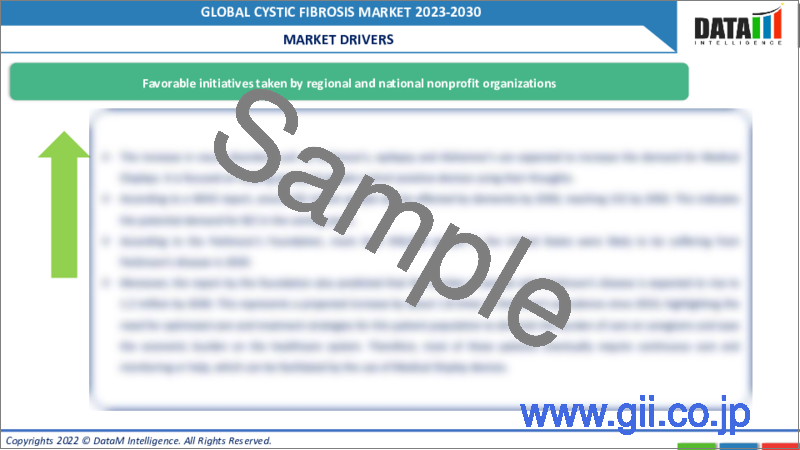|
|
市場調査レポート
商品コード
1138398
嚢胞性線維症の世界市場-2022-2029Global Cystic Fibrosis Market - 2022-2029 |
||||||
|
● お客様のご希望に応じて、既存データの加工や未掲載情報(例:国別セグメント)の追加などの対応が可能です。 詳細はお問い合わせください。 |
|||||||
| 嚢胞性線維症の世界市場-2022-2029 |
|
出版日: 2022年10月18日
発行: DataM Intelligence
ページ情報: 英文 180 Pages
納期: 約2営業日
|
- 全表示
- 概要
- 目次
市場力学
主な原動力は、有病率の増加、パイプライン医薬品の需要増加、嚢胞性線維症治療に関するヘルスケア業界の意識の高まり、および非営利団体による好意的な取り組みです。
地域や国の非営利団体による積極的な取り組みが、市場成長の原動力となることが期待されます。
成長を促進する主な要因の1つは、地域および国の非営利団体によって行われる積極的な活動です。これらのプロジェクトは、CF患者を支援します。これらの組織は、これらの治療薬の研究開発活動を支援し、これらの患者の生活の質を向上させるのに役立っています。例えば、北米嚢胞性線維症会議(NACFC)は、嚢胞性線維症の専門家がCF治療薬に関連する研究開発の進歩を共有するための協力的で教育的なフォーラムを提供します。また、2019年9月12日に5年間の契約が発表され、それによると、NHSスコットランドはOrkambiやSymkeviなどの嚢胞性線維症薬に年間10万ポンドを提供することを決定しています。このように、有利な取り組みが市場を牽引しています。
さらに、主要なプレーヤーは、治療のための新しい治療薬を開発するために非営利団体と協力しながら、市場で活動しています。臨床試験中の薬剤としては、Vertex社が、F508del変異1つと最小限のCFTR変異1つ、またはF508del変異2つを有する18歳以上のCF患者を対象に、次世代3剤併用療法であるVX-121+tezacaftor+VX-561(deutivacaftor)の第II相試験(NCT03912233)1件を終了しています。したがって、上記の記述から、予測期間中に市場が牽引されることが予想されます。
制約事項
しかし、CFは希少疾患であるため、得られる情報が限られており、広範な調査が不可欠です。CFの研究開発費は非常に高額であり、最終製品の価格の高騰につながっています。薬剤や治療費の高騰は、嚢胞性線維症市場の成長を阻害する要因の一つです。
産業分析
嚢胞性線維症市場は、アンメットニーズ、価格分析、サプライチェーン分析、規制分析など、様々な業界要因に基づいた市場の詳細な分析を提供します。
世界の嚢胞性線維症市場レポートでは、約45+市場データ表、40+図、180ページの構成で提供しています。
目次
第1章 調査手法と調査範囲
- 調査手法
- 調査目的および調査範囲
第2章 市場の定義と概要
第3章 エグゼクティブサマリー
第4章 市場の力学
- 市場影響要因
- 促進要因
- 地域や国の非営利団体別積極的な取り組みが、市場成長の原動力になると予想されます。
- 抑制要因
- 薬代や治療費の高騰が市場成長の妨げになると予想されます。
- 機会
- 影響分析
- 促進要因
第5章 産業分析
- ポーターの5つの力
- アンメットニーズ
- サプライチェーン
- プライシング分析
- 規制分析
第6章 COVID-19の分析
- COVID-19の市場分析
- COVID-19以前の市場シナリオ
- COVID-19の現在の市場シナリオ
- COVID-19の後、または将来のシナリオ
- COVID-19の中での価格ダイナミクス
- 需要-供給スペクトラム
- パンデミック時の市場に関連する政府の取り組み
- メーカーの戦略的な取り組み
- まとめ
第7章 薬剤クラス別
- CFTRモジュレーター
- カリデコ(イバカフトール)
- オルカンビ(ルマカフター/イバカフター)
- Symdeko(テザカフトール/イバカフトール)
- トリカフタ(エレキサカフター/テザカフター/イバカフター)
- 膵臓酵素サプリメント
- 粘液溶解剤
- 気管支拡張剤
第8章 投与経路別
- 経口
- 吸入
- 非経口
第9章 流通経路別
- 病院内薬局
- オンライン薬局
- 小売薬局
第10章 地域別
- 北米
- 米国
- カナダ
- メキシコ
- 欧州
- ドイツ
- 英国
- フランス
- イタリア
- スペイン
- その他欧州
- 南米
- ブラジル
- アルゼンチン
- その他の南米地域
- アジア太平洋地域
- 中国
- インド
- 日本
- オーストラリア
- その他アジア太平洋地域
- 中東・アフリカ地域
第11章 競合情勢
- 競合シナリオ
- 市況/シェア分析
- M&A(合併・買収)分析
第12章 企業プロファイル
- Vertex Pharmaceuticals Inc.
- 企業概要
- 製品ポートフォリオと説明
- 主なハイライト
- 財務概要
- AbbVie Inc
- F. Hoffmann-La Roche Ltd
- Novartis AG
- Teva Pharmaceutical Industries Ltd
- Gilead sciences
- Allergan
- AstraZeneca
- Alcresta Therapeutics Inc.
- Merck & Co. Inc
Market Overview
Cystic Fibrosis Market is estimated to reach at a CAGR of 13.2% during the forecast period (2022-2029).
Cystic fibrosis (CF) is a life-limiting autosomal recessive genetic disorder that causes severe damage to secretory glands of the body, like the lungs, pancreas, liver, and intestines. It is more common in the lungs. The disease is caused by the mutation of a gene that encodes a chloride-conducting transmembrane channel called the cystic fibrosis transmembrane conductance regulator (CFTR).
Market Dynamics
The major driving forces are the increasing prevalence, rising demand for pipeline drugs, increasing awareness among the healthcare fraternity about cystic fibrosis therapy, and favorable initiatives undertaken by nonprofit organizations.
Favorable initiatives taken by regional and national nonprofit organizations are expected to drive market growth.
One of the primary factors driving growth is the positive actions performed by regional and national nonprofit groups. These projects assist CF patients. These organizations aid in the research & development activities of these therapeutics and help improve the quality of life of these patients. For instance, the North American Cystic Fibrosis Conference (NACFC) provides a collaborative and educational forum for cystic fibrosis professionals to share advances in R&D related to CF therapeutics. Also, a five-year deal was announced on 12 September 2019, according to which the NHS Scotland has decided to provide £ 100,000 per year for cystic fibrosis drugs like Orkambi and Symkevi. Thus, favorable initiatives are driving the market.
Moreover, the key players are operating in the market, collaborating with nonprofit organizations to develop novel therapeutics for the treatment. Some of the drugs in clinical trials are Vertex has completed one Phase II study (NCT03912233) of their next-generation triple combination therapy, VX-121 + tezacaftor + VX-561 (deutivacaftor), in CF patients aged 18 and older with one F508del mutation and one minimal function CFTR mutation, or two F508del mutations. Thus, from the above statements, the market is expected to drive in the forecast period.
Restraint:
However, due to the limited information available, extensive research is essential as CF is a rare disease. The research and development cost for CF is very high, leading to the enormous prices of the end products. The high cost of drugs and treatment is one of the factors that hamper the growth of the cystic fibrosis market.
Industry Analysis
The cystic fibrosis market provides in-depth analysis of the market based on various industry factors such as unmet needs, pricing analysis, supply chain analysis, regulatory analysis etc.
Segment Analysis
CFTR modulators segment is expected to hold the largest market share in the cystic fibrosis market.
The CFTR modulators segment accounted for the largest market share in 2021. This is owing to the increased number of US FDA approvals of the drugs. For instance, Ivacaftor (KALYDECO), a CFTR modulator introduced by Vertex pharmaceuticals, was developed in conjunction with the Cystic fibrosis Foundation (CFF). Also, on June 21, 2019, the US FDA approved SYMDEKO (tezacaftor/ivacaftor and ivacaftor) of Vertex pharmaceuticals to treat Cystic fibrosis in children ages 6-11 years with specific mutations in the CFTR gene. Moreover, On Apr. 19, 2022, The Cystic Fibrosis Foundation invested $5 million in Sionna Therapeutics company. The company is focused exclusively on developing cystic fibrosis transmembrane conductance regulator (CFTR) modulators, a type of therapy that treats the underlying cause of CF. Sionna is developing a pipeline of potential modulators that could benefit people with the most common CF-causing mutation, F508del, and may eventually offer an alternative to currently approved CFTR modulators. The novel modulators target NBD1, the gene region where the F508del mutation occurs. No modulator currently on the market targets NBD1. Thus, from the above statements, the market segment is expected to hold the largest market share in the forecast period.
Geographical Analysis
North American region is expected to hold the largest market share in the global cystic fibrosis market.
North America accounted for the highest revenue share in 2021. The rising prevalence of cystic fibrosis and the presence of government initiatives are the factors to drive in the forecast period. For instance, according to the cystic fibrosis foundation (CFF), there are close to 40,000 children and adults living with cystic fibrosis in the United States (and an estimated 105,000 people have been diagnosed with CF across 94 countries), and CF can affect people of every racial and ethnic group. According to the CFF's national patient registry, the median age of a person with CF is currently 33.4 years. The average life expectancy of CF patients has increased significantly compared to the patients 30 years back. Thus, the increasing prevalence of CF has boosted North America's share in the global cystic fibrosis market.
Furthermore, Hopkins University and Medicine researchers developed a novel treatment for a pathogen in December 2020. Mycobacterium abscesses are a pathogen that is drug-resistant and harmful to persons with lung diseases or cystic fibrosis. Thus, from the above statements, the North American region is expected to hold the largest market share in the forecast period.
Competitive Landscape
Major key players in the cystic fibrosis market are Vertex Pharmaceuticals Inc., AbbVie Inc., F. Hoffmann-La Roche Ltd., Novartis AG, Teva Pharmaceutical Industries Ltd, Gilead Sciences, Allergan, AstraZeneca, Alcresta Therapeutics Inc., and Merck & Co. Inc.
Vertex Pharmaceuticals, Inc.:
Overview:
Vertex Pharmaceuticals, Inc. was founded by Joshua S. Boger in 1989 and is headquartered in Boston, MA. The company discovers, develops, manufactures and commercializes small molecule drugs for patients with serious diseases. It focuses on developing and commercializing therapies for the treatment of cystic fibrosis, infectious diseases including viral infections such as influenza and bacterial infections, autoimmune diseases such as rheumatoid arthritis, cancer, inflammatory bowel disease and neurological disorders including pain and multiple sclerosis.
Product Portfolio:
TRIKAFTA (elexacaftor/tezacaftor/ivacaftor and ivacaftor): TRIKAFTA is a prescription medicine used for the treatment of cystic fibrosis (CF) in patients aged 6 years and older who have at least one copy of the F508del mutation in the cystic fibrosis transmembrane conductance regulator (CFTR) gene or another mutation that is responsive to treatment with TRIKAFTA.
The global cystic fibrosis market report would provide an access to an approx. 45+market data table, 40+figures and 180pages.
Table of Contents
1. Methodology and Scope
- 1.1. Research Methodology
- 1.2. Research Objective and Scope of the Report
2. Market Definition and Overview
3. Executive Summary
4. Market Dynamics
- 4.1. Market Impacting Factors
- 4.1.1. Drivers
- 4.1.1.1. Favorable initiatives taken by regional and national nonprofit organizations are expected to drive market growth.
- 4.1.2. Restraints:
- 4.1.2.1. The high cost of drugs and treatment are expected to hamper the market growth.
- 4.1.3. Opportunity
- 4.1.4. Impact Analysis
- 4.1.1. Drivers
5. Industry Analysis
- 5.1. Porter's Five Forces
- 5.2. Unmet Needs
- 5.3. Supply Chain
- 5.4. Pricing Analysis
- 5.5. Regulatory Analysis
6. COVID-19 Analysis
- 6.1. Analysis of Covid-19 on the Market
- 6.1.1. Before COVID-19 Market Scenario
- 6.1.2. Present COVID-19 Market Scenario
- 6.1.3. After COVID-19 or Future Scenario
- 6.2. Pricing Dynamics Amid Covid-19
- 6.3. Demand-Supply Spectrum
- 6.4. Government Initiatives Related to the Market During Pandemic
- 6.5. Manufacturers Strategic Initiatives
- 6.6. Conclusion
7. By Drug Class
- 7.1. Introduction
- 7.1.1. Market Size Analysis, and Y-o-Y Growth Analysis (%), By Drug Class
- 7.1.2. Market Attractiveness Index, By Drug Class Segment
- 7.2. CFTR modulators*
- 7.2.1.1. Kalydeco (ivacaftor)
- 7.2.1.2. Introduction
- 7.2.1.3. Market Size Analysis, US$ Million, 2020-2029 and Y-o-Y Growth Analysis (%), 2021-2029
- 7.2.1.4. Orkambi (lumacaftor/ivacaftor)
- 7.2.1.5. Symdeko (tezacaftor/ivacaftor)
- 7.2.1.6. Trikafta (elexacaftor/tezacaftor/ivacaftor)
- 7.3. Pancreatic enzyme supplements
- 7.4. Mucolytics
- 7.5. Bronchodilators
8. By Route of Administration
- 8.1. Introduction
- 8.1.1. Market Size Analysis, and Y-o-Y Growth Analysis (%), By Route of Administration
- 8.1.2. Market Attractiveness Index, By Route of Administration Segment
- 8.2. Oral*
- 8.2.1. Introduction
- 8.2.2. Market Size Analysis, US$ Million, 2020-2029 and Y-o-Y Growth Analysis (%), 2021-2029
- 8.3. Inhaled
- 8.4. Parenteral
9. By Distribution Channel
- 9.1. Introduction
- 9.1.1. Market Size Analysis, and Y-o-Y Growth Analysis (%), By Distribution Channel
- 9.1.2. Market Attractiveness Index, By Distribution Channel Segment
- 9.2. Hospital Pharmacies*
- 9.2.1. Introduction
- 9.2.2. Market Size Analysis, US$ Million, 2020-2029 and Y-o-Y Growth Analysis (%), 2021-2029
- 9.3. Online Pharmacies
- 9.4. Retail Pharmacies
10. By Region
- 10.1. Introduction
- 10.1.1. Market Size Analysis, US$ Million, 2020-2029 and Y-o-Y Growth Analysis (%), 2021-2029, By Region
- 10.1.2. Market Attractiveness Index, By Region
- 10.2. North America
- 10.2.1. Introduction
- 10.2.2. Key Region-Specific Dynamics
- 10.2.3. Market Size Analysis, and Y-o-Y Growth Analysis (%), By Drug Class
- 10.2.4. Market Size Analysis, and Y-o-Y Growth Analysis (%), By Route of Administration
- 10.2.5. Market Size Analysis, and Y-o-Y Growth Analysis (%), By Distribution Channel
- 10.2.6. Market Size Analysis, and Y-o-Y Growth Analysis (%), By Country
- 10.2.6.1. U.S.
- 10.2.6.2. Canada
- 10.2.6.3. Mexico
- 10.3. Europe
- 10.3.1. Introduction
- 10.3.2. Key Region-Specific Dynamics
- 10.3.3. Market Size Analysis, and Y-o-Y Growth Analysis (%), By Drug Class
- 10.3.4. Market Size Analysis, and Y-o-Y Growth Analysis (%), By Route of Administration
- 10.3.5. Market Size Analysis, and Y-o-Y Growth Analysis (%), By Distribution Channel
- 10.3.6. Market Size Analysis, and Y-o-Y Growth Analysis (%), By Country
- 10.3.6.1. Germany
- 10.3.6.2. U.K.
- 10.3.6.3. France
- 10.3.6.4. Italy
- 10.3.6.5. Spain
- 10.3.6.6. Rest of Europe
- 10.4. South America
- 10.4.1. Introduction
- 10.4.2. Key Region-Specific Dynamics
- 10.4.3. Market Size Analysis, and Y-o-Y Growth Analysis (%), By Drug Class
- 10.4.4. Market Size Analysis, and Y-o-Y Growth Analysis (%), By Route of Administration
- 10.4.5. Market Size Analysis, and Y-o-Y Growth Analysis (%), By Distribution Channel
- 10.4.6. Market Size Analysis, and Y-o-Y Growth Analysis (%), By Country
- 10.4.6.1. Brazil
- 10.4.6.2. Argentina
- 10.4.6.3. Rest of South America
- 10.5. Asia Pacific
- 10.5.1. Introduction
- 10.5.2. Key Region-Specific Dynamics
- 10.5.3. Market Size Analysis, and Y-o-Y Growth Analysis (%), By Drug Class
- 10.5.4. Market Size Analysis, and Y-o-Y Growth Analysis (%), By Route of Administration
- 10.5.5. Market Size Analysis, and Y-o-Y Growth Analysis (%), By Distribution Channel
- 10.5.6. Market Size Analysis, and Y-o-Y Growth Analysis (%), By Country
- 10.5.6.1. China
- 10.5.6.2. India
- 10.5.6.3. Japan
- 10.5.6.4. Australia
- 10.5.6.5. Rest of Asia Pacific
- 10.6. Middle East and Africa
- 10.6.1. Introduction
- 10.6.2. Key Region-Specific Dynamics
- 10.6.3. Market Size Analysis, and Y-o-Y Growth Analysis (%), By Drug Class
- 10.6.4. Market Size Analysis, and Y-o-Y Growth Analysis (%), By Route of Administration
- 10.6.5. Market Size Analysis, and Y-o-Y Growth Analysis (%), By Distribution Channel
11. Competitive Landscape
- 11.1. Competitive Scenario
- 11.2. Market Positioning/Share Analysis
- 11.3. Mergers and Acquisitions Analysis
12. Company Profiles
- 12.1. Vertex Pharmaceuticals Inc.*
- 12.1.1. Company Overview
- 12.1.2. Product Portfolio and Description
- 12.1.3. Key Highlights
- 12.1.4. Financial Overview
- 12.2. AbbVie Inc
- 12.3. F. Hoffmann-La Roche Ltd
- 12.4. Novartis AG
- 12.5. Teva Pharmaceutical Industries Ltd
- 12.6. Gilead sciences
- 12.7. Allergan
- 12.8. AstraZeneca
- 12.9. Alcresta Therapeutics Inc.
- 12.10. Merck & Co. Inc




